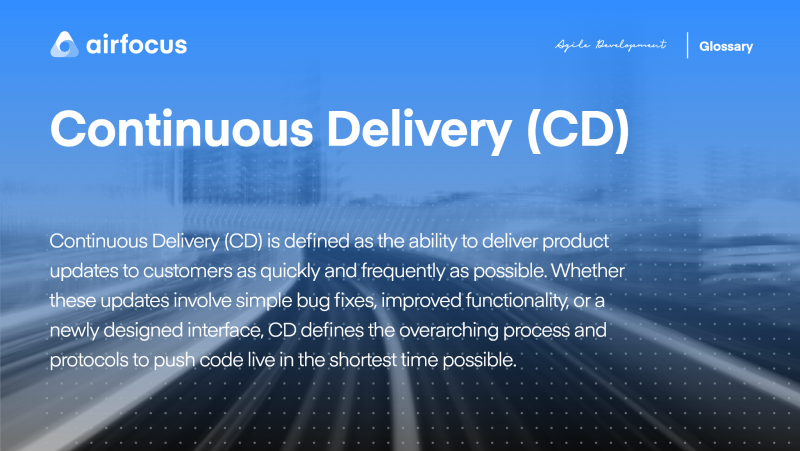Continuous Delivery (CD)
What is continuous delivery (CD)
Definition of continuous delivery (CD)
Continuous delivery (CD) is defined as the ability to deliver product updates to customers as quickly and frequently as possible. Whether these updates involve simple bug fixes, improved functionality, or a newly designed interface, CD defines the overarching process and protocols to push code live in the shortest time possible.
History of continuous delivery
When software development first emerged as a field, many teams relied on a waterfall methodology for their software development life cycle (SDLC). This changed in the 90’s, thanks to agile software development practices, which empowered teams to ship little and often, rather than developing an entire product upfront.
Having the ability to make changes on incremental levels, new frameworks based on agile principles quickly became the norm for many teams. These frameworks included approaches such as continuous delivery, DevOps, and continuous deployment, which have since risen to a new level of popularity.
Though all of these concepts fall under the umbrella of agile frameworks, some notable distinctions and implications set them apart. In this article, we’ll dive into continuous delivery, outlining what it is exactly, as well as some of its primary benefits and challenges.
How CD works in the software development process
It’s critical to understand that continuous delivery is not the same process as continuous deployment. These two may seem easy to confuse, but they serve very different purposes in the software development lifecycle (SDLC).
Here is how these two processes relate to one another:
Continuous deployment refers to the frequent implementation of changes automatically. This is usually by way of multiple daily updates.
Continuous delivery is having the ability to deploy software changes frequently and is necessary to practice continuous deployment. It is more of a mindset and culture than an actual practice.
This form of delivery also has its own defined framework, though it may vary between companies and product needs. Key processes that are typically part of continuous delivery include planning changes, the actual development of these updates, testing, code merging, retesting, pushing live, and validation.
Many software teams work to keep the majority of this process automated and easily reproduced to speed things up.
What are the primary principles of CD?
Award-winning author, Jez Humble, outlined five primary principles for a successful continuous delivery process. In his book (Continuous Delivery: Reliable Software Releases Through Build, Test, and Deployment Automation), he recommends following these five guidelines:
Quality needs to be built-in to production workflows
Development and release batches should be kept small
People should solve issues and leave repetitive duties to computers
Continuous improvement should be an ongoing goal
Accountability belongs to everyone
The Agile Manifesto has many principles that align with those mentioned above. This also highlights how continuous delivery is an adaptation of agile, along with its related ideas.
Benefits of continuous delivery
Continuous delivery has wide-reaching benefits for product teams.
The frequency of feedback loops is one of the most notable of these benefits. For every newly delivered update, you earn a fresh opportunity for customers to give feedback. This translates into more frequent windows for valuable insights every time you push a new update.
In this way, continuous delivery reduces risk. Software development comes with some level of uncertainty when working on new initiatives. The resources involved in developing products is a costly process, so it’s important that ideas are validated as early on in the process as possible. Continuous delivery makes this a reality, thanks to an increased number of feedback loops.
Businesses are now shifting to a mindset of expecting a culture of continuous delivery. It is no longer a competitive advantage, but rather a requirement to stay above the fray.
Why your team should use continuous delivery
CD demonstrates that frequent deployment does not harm the stability or reliability of our software systems. In fact, it has provided businesses around the world with a competitive advantage.
Here are some of the key benefits of integrating continuous delivery into your product process:
Releases pose minimal risks
CD has a laser-focused goal of creating a painless deployment process that is a low-risk by nature and is largely automated. For many software teams, this translates to something known as ‘zero-downtime deployment’. which leaves users unaware that updates have taken place. This means that businesses can continuously iterate and improve products in a non-intrusive way, which in turn may lead to increased user retention.
Get to market fast
Through CD, teams can automate much of the deployment processes, including regression and environmental testing. By allowing them to remove these phases out of daily tasks, teams can ship products to market much more quickly (and iteratively).
Produce higher quality products
Continuous delivery allows teams to quickly discover and correct issues, empowering them to develop a sharper understanding of key usability requirements. This, in turn, promotes a more user-centric mindset, which leads to overall improvements in the quality of the final product.
Increase team morale
Continuous delivery promotes a culture of shipping updates more frequently and in smaller batches. This helps your team avoid burnout, and gives a greater sense of progression on a continual basis. The mindset that this promotes also engage software developers with end-users, motivating them to produce quality deliverables that consumers enjoy.

General FAQ

Glossary categories
Experience the new way of doing product management

Experience the new way of doing product management








